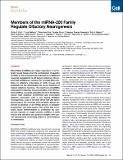| dc.contributor.author | Choi, Philip S. | |
| dc.contributor.author | Zakhary, Lisa | |
| dc.contributor.author | Choi, Wen-Yee | |
| dc.contributor.author | Caron, Sophie | |
| dc.contributor.author | Alvarez-Saavedra, Ezequiel | |
| dc.contributor.author | Miska, Eric A. | |
| dc.contributor.author | McManus, Mike | |
| dc.contributor.author | Harfe, Brian | |
| dc.contributor.author | Giraldez, Antonio J. | |
| dc.contributor.author | Schier, Alexander F. | |
| dc.contributor.author | Dulac, Catherine | |
| dc.contributor.author | Horvitz, Howard Robert | |
| dc.date.accessioned | 2012-09-17T15:20:06Z | |
| dc.date.available | 2012-09-17T15:20:06Z | |
| dc.date.issued | 2008-01 | |
| dc.date.submitted | 2007-09 | |
| dc.identifier.uri | http://hdl.handle.net/1721.1/72991 | |
| dc.description.abstract | MicroRNAs (miRNAs) are highly expressed in vertebrate neural tissues, but the contribution of specific miRNAs to the development and function of different neuronal populations is still largely unknown. We report that miRNAs are required for terminal differentiation of olfactory precursors in both mouse and zebrafish but are dispensable for proper function of mature olfactory neurons. The repertoire of miRNAs expressed in olfactory tissues contains over 100 distinct miRNAs. A subset, including the miR-200 family, shows high olfactory enrichment and expression patterns consistent with a role during olfactory neurogenesis. Loss of function of the miR-200 family phenocopies the terminal differentiation defect observed in absence of all miRNA activity in olfactory progenitors. Our data support the notion that vertebrate tissue differentiation is controlled by conserved subsets of organ-specific miRNAs in both mouse and zebrafish and provide insights into control mechanisms underlying olfactory differentiation in vertebrates. | en_US |
| dc.description.sponsorship | National Institutes of Health. (U.S.) (grant NS049319) | |
| dc.description.sponsorship | National Institutes of Health. (U.S.) (grant GM56211) | |
| dc.description.sponsorship | Wellcome Trust (London, England) (grant 066790/B/02/Z) | |
| dc.language.iso | en_US | |
| dc.publisher | Elsevier B.V. | en_US |
| dc.relation.isversionof | http://dx.doi.org/10.1016/j.neuron.2007.11.018 | en_US |
| dc.rights | Article is made available in accordance with the publisher's policy and may be subject to US copyright law. Please refer to the publisher's site for terms of use. | en_US |
| dc.source | Elsevier | en_US |
| dc.title | Members of the miRNA-200 Family Regulate Olfactory Neurogenesis | en_US |
| dc.type | Article | en_US |
| dc.identifier.citation | Choi, Philip S. et al. “Members of the miRNA-200 Family Regulate Olfactory Neurogenesis.” Neuron 57.1 (2008): 41–55. Web. | en_US |
| dc.contributor.department | Massachusetts Institute of Technology. Department of Biology | en_US |
| dc.contributor.approver | Horvitz, H. Robert | |
| dc.contributor.mitauthor | Horvitz, H. Robert | |
| dc.contributor.mitauthor | Alvarez-Saavedra, Ezequiel | |
| dc.contributor.mitauthor | Miska, Eric A. | |
| dc.relation.journal | Neuron | en_US |
| dc.eprint.version | Final published version | en_US |
| dc.type.uri | http://purl.org/eprint/type/JournalArticle | en_US |
| eprint.status | http://purl.org/eprint/status/PeerReviewed | en_US |
| dspace.orderedauthors | Choi, Philip S.; Zakhary, Lisa; Choi, Wen-Yee; Caron, Sophie; Alvarez-Saavedra, Ezequiel; Miska, Eric A.; McManus, Mike; Harfe, Brian; Giraldez, Antonio J.; Horvitz, Robert H.; Schier, Alexander F.; Dulac, Catherine | en |
| dc.identifier.orcid | https://orcid.org/0000-0002-9964-9613 | |
| mit.license | PUBLISHER_POLICY | en_US |
| mit.metadata.status | Complete | |
